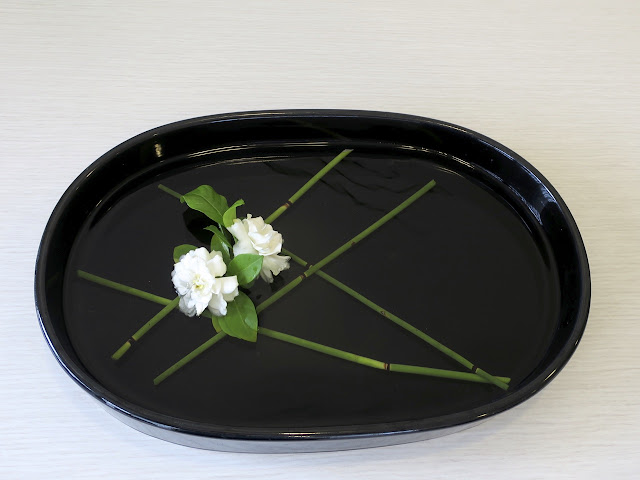This week I set my Geelong students the Sogetsu curriculum exercise of 'Using leaves only'. I enjoy this exercise as it is one in which we are encouraged to look carefully at the material and observe its natural qualities of colour, texture and pliability.
The text book says '...leaves can give an entirely different impression by showing their reverse side...'. We are encouraged to explore their plasticity by, '...cutting, tearing, rolling or overlapping them...'. This comment brings to my mind the caution of Mr Umemura at a workshop once, when he said that if you are going to change the appearance of leaves then you have to enhance their beauty, because nature made them perfect in the first place.
Ellie has used a large 'fan' palm leaf, characterised by radiating lines, against which she has contrasted Maranta leuconeura leaves, the reverse side of which are a deep maroon.
Christine arranged two Strelitzia leaves in a dark grey rectangular box-shaped vessel. She has added rolled and knotted maroon Cordyline leaves in the fold of the front Strelitzia leaf, to create a quirky modern arrangement. The tip of another cordyline leaf projects to the right from the second strelitzia leaf.
On Monday I attended the Annual General Meeting of the Victorian Branch of the Sogetsu School of Ikebana (SSIV). We were pleased to welcome 38 members, including 5 new and 2 returning members over the last 12 months. Following the meeting a workshop was led by Angeline Lo on the theme of a 'No kenzan' arrangement in a suiban.
This is my re-constructed arrangement at home. I used some pittosporum branches that were quite fine and rather flexible; probably not the best material for the exercise. For the focal point I used some unidentified blue flowers. More photos can be seen at SSIV AGM meeting.
A couple of weeks ago I found a single stem of Belladonna flowers, Amaryllis belladonna growing by the nearby creek. In our garden the flowers have not appeared, because of the extra dry season. My grandmother always associated this flower with my birthday in mid-February.
I picked the flower and arranged it with the blue-grey leaves of a succulent in a rarely used bowl. The bowl is by Ray Pearce a very skilled and imaginative potter who has lived and worked in the Bendigo area for many years.
A week later the some of the flowers had drooped so I re-worked the arrangement. It was good to get some extra life out of these long-lasting materials.
Greetings from Christopher
23rd February 2019






















